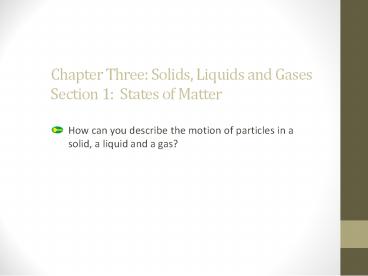Chapter Three: Solids, Liquids and Gases Section 1: States of Matter - PowerPoint PPT Presentation
1 / 12
Title:
Chapter Three: Solids, Liquids and Gases Section 1: States of Matter
Description:
Chapter Three: Solids, Liquids and Gases Section 1: States of Matter How can you describe the motion of particles in a solid, a liquid and a gas? – PowerPoint PPT presentation
Number of Views:223
Avg rating:3.0/5.0
Title: Chapter Three: Solids, Liquids and Gases Section 1: States of Matter
1
Chapter Three Solids, Liquids and GasesSection
1 States of Matter
- How can you describe the motion of particles in a
solid, a liquid and a gas?
2
Solids
- The particles in a solid are closely locked in
position and can only vibrate, as they do not
have enough energy to slide past one another.
3
- There are 2 types of solids
- Crystalline Solids
- Amorphous Solids
4
Crystalline Solids
- Particles form a regular repeating pattern.
- These patterns create crystals.
- Examples Salt, Sugar, Snow, Quartz
- Melts at a specific temperature
5
Amorphous Solids
- Particles are not arranged in a regular pattern.
- Examples Plastic, Rubber, Glass, Butter
- Does not melt at a distinct temperature, may
become softer or change into other substances.
6
Liquids
- In general, particles in a liquid are packed
almost as closely as a solid, but the particles
move freely. - Compared to particles in a solid, the particles
in a liquid are more loosely connected and can
collide with and move past one another. - This is why a liquid flows and has no definite
shape.
7
Properties of Liquids
- Surface Tension
- Result of an inward pull among the molecules of a
liquid that brings the molecules on the surface
closer together - Causes water to bead up and insects to walk on
water
- Viscosity
- A liquids resistance to flowing
- Depends on size and shape of particles and
attraction between them - High viscosity slow flow, like honey
- Low viscosity quick flow, like water
8
Gases
- In gases, the atoms and molecules are free to
move independently, colliding frequently.
9
FLUIDS Fluid means a substance that
flows. Both liquids and gases are considered
fluids.
10
LETS REVIEW!
- In Which type of Solid do particles form a
regular repeating pattern?
Crystalline Solid
- What type of solid is butter?
Amorphous Solid
11
LETS REVIEW!
- What are the 3 States of Matter?
Solid, Liquid, Gas
- Which state of matter has a definite volume, but
no shape of its own?
Liquid
12
LETS REVIEW!
- What state of matter is not considered a fluid?
Solids
- Does juice have a high or low viscosity?
Low































